
A Tibetan woman lies on the road as part of a sit-in protest at the mine in Lhagang.
A lithium mining project has been called to a temporary halt in eastern Tibet after local people protested. Footage emerged from Tibet last week showing Tibetan women wailing at the sight of dead fish found in a local river, a tributary of the Yangtze [Tibetan: Drichu], as a result of toxic wastes caused by the mining. A line of Chinese police in riot gear could be seen on the videos responding to the protest in Lhagang (Chinese: Tagong) in Kham, where rock lithium is mined – an essential mineral for batteries that power mobile phones and tablets.
An official document dated May 6, two days after local people gathered at the site to protest, stated that the local authorities were calling a halt to the mining because of “environmental problems” and in order to “resolve remaining issues”. ICT has seen a photograph of the document, which had an official stamp, after it was circulated on social media. A full translation into English is provided below.
Exile Tibetans reported that the death of the fish occurred after a Chinese company re-started lithium mining in the area, in Lhagang township, Kardze (Chinese: Ganzi) Tibetan Autonomous Prefecture,[1] Sichuan province, in the Tibetan area of Kham, which resulted in toxic waste in the Lichu river. Lhagang is close to Nyagchu (Chinese: Yajiang), where Tenzin Delek Rinpoche, who died in July in prison, was from.[2] Mining at the location had been postponed since 2013, but was resumed on April 11. Voice of America reported that it was postponed after an official investigation linked pollution with a die-off of aquatic life.[3] It is not known whether a further reason for the postponement was that the mining at Lhagang is for rock lithium, which is expensive compared to salt lake extraction of lithium that happens elsewhere in Tibet particularly in the Tsaidam Basin in Qinghai.[4]
According to VOA, a Tibetan man whose face is not visible on the video can be heard saying: “This is how things are — the nation’s military is sent [on us] to crack down on us.” Another says: “This is how things are, brothers and sisters of Tibetans,” said another. “This is what Chinese do!”
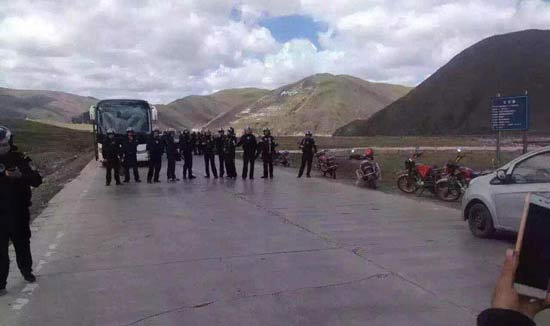
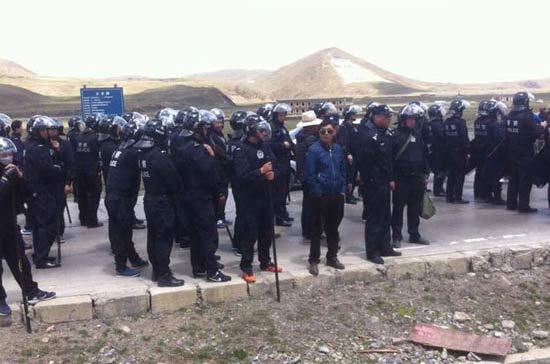 Armed police in riot gear at the protest on May 4.
Armed police in riot gear at the protest on May 4.
A monk from South India named Aka Penpa told the Tibet Post that the mining had led to toxic waste being dumped into the river, and around 100 people had gathered to demand an end to the mining and urgent action to protect the environment and wildlife. He said that dozens of police forces in vehicles had been deployed to the protest site immediately as a result.[5]
The official document, apparently issued by the governments of Kardze Tibetan Autonomous Prefecture and of Dartsedo (Chinese: Kangding) City, refers specifically to the impact of the mining on the local environment, specifically mentioning “problems”, and local peoples’ concern about it. It appears that stopping the mining is likely to be temporary, but it is still a significant move by the local authorities.
Protests against mining and to protect Tibet’s fragile high-altitude environment have become increasingly frequent, and dangerous, as the Chinese authorities accelerate large-scale mining in copper, gold, silver, chromium and lithium. Tibetans who express even moderate concern about the impact of toxic waste, deforestation, and large-scale erosion risk being imprisoned, tortured, or killed.
In Lhagang, the political stakes are high since the discovery of a major reserve of lithium and rare earths, known as the Jiajika deposit. This became particularly important to China when the demand for lithium intensified due to the lithium-ion battery that powers smartphones and tablets.
The prospects of a lithium boom have attracted investors worldwide to the lithium deposits of Tibet, including Warren Buffett and Bill Gates, as part of their backing for a Chinese manufacturer, BYD, hoping to become a successful electric car manufacturer. According to Gabriel Lafitte, author of a major book on mining in Tibet,[6] BYD claims exclusive rights to mine lithium, not from the massive salt pans of the Tsaidam Basin, but the Chabyer Tsaka in arid upper Tibet, a big area where lakes have inlets but no outlets and were, until recent climate change, gradually shrinking, leaving behind their salts.
Chabyer Tsaka (Zhabuye in Chinese), despite its extreme remoteness, was intensively investigated by Chinese geologists starting in the 1950s, initially for its five million tons of boron, used in moderating temperatures in nuclear reactors; later for the many other minerals concentrated there, including lithium, and most recently, uranium.[7]
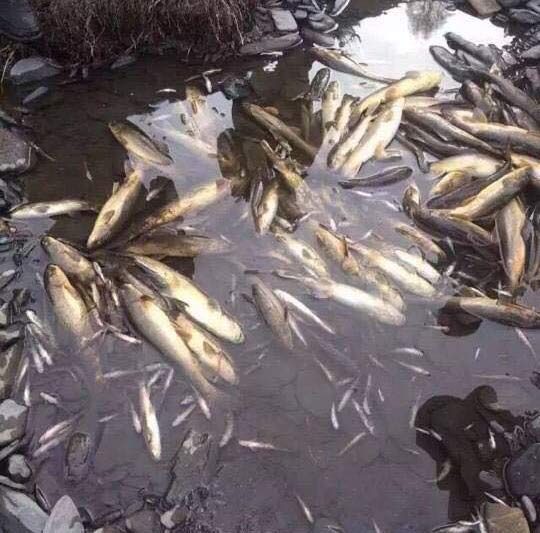
Dead fish, believed to be killed from toxic wastes from the Lhagang rock lithium mining project.
Gabriel Lafitte writes: “Lithium extraction from the salt lakes of Tibet is now a big industry, concentrated in the arid Tsaidam Basin of Amdo, but also attracting Chinese and global investors to far western Tibet as well. The ease of scooping up the salts of the dry or shallow, briny lakebeds has made lithium removal easy, and by comparison, the extraction of lithium from hard rock, as in Tulku Tenzin Delek’s home (the Nyagchu area), comparatively more expensive.”
But Gabriel Lafitte also warns that: “As lithium batteries become more central to daily life, from smartphones to electric cars and buses, manufacturers will demand lithium of higher purity. Using solvents to separate lithium from the other salts scooped from dry Tibetan salt lakes may no longer be good enough for the new generation of lithium batteries under development. One solution will be to turn to the hard rock lithium deposits such as Nyagchu, which Tulku Tenzin Delek tried to protect, which cost him his life.”[8]
The Chinese manufacturer BYD, which attracted the attention of Warren Buffet and Bill Gates, has since shifted to buses running on lithium iron phosphate batteries, and has been demonstrating them to bus companies in the US and now London. In the UK, the Duke and Duchess of Cambridge, William and Kate, were pictured with China’s leader Xi Jinping last October in London climbing onboard an electronic bus built by BYD.[9]
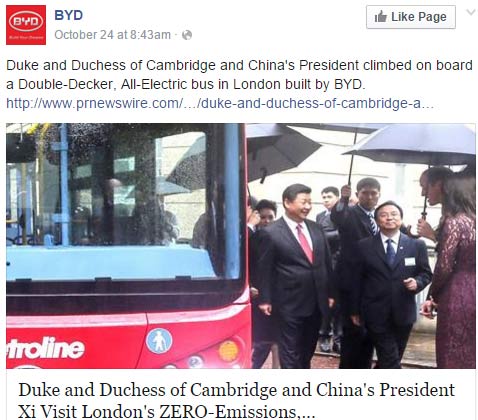
A screengrab of BYD’s social media on October 24. The image was posted with the caption: “Duke and Duchess of Cambridge and China’s President climbed on board a Double-Decker, All-Electric bus built by BYD.”
The text of the official document from Kardze announcing the temporary stop of the mining operation is translated below from Chinese into English:
The People’s Government of Ganzi Tibetan Autonomous Prefecture and the People’s Government of Kangding City solemnly commit: the mining by the Rongdali Company in the Jiajika spodumene[10] mining development has caused environmental problems and since no consensus has yet been reached with the people, there will be no mining until the relevant remaining issues have been resolved.
Solemnly commit!
On May 6, 2016.
Signed: People’s Government of Ganzi Tibetan Autonomous Prefecture and People’s Government of Kangding City
Nomad loses battle to protect pastureland from gold mining
In a further development, a Tibetan nomad lost a battle to protect local pastures from gold mining. According to various Tibetan sources, on May 3, a Chinese mining company, working with the local authorities, opened a gold mine in Karchen Township, Trindu (Chinese: Chenduo) County, Kyegudo (Chinese: Yushu) Tibetan Autonomous Prefecture in Qinghai Province.
A Tibetan source in exile familiar with the development told ICT that the company had been working closely with the local authorities to open mining sites in the area, with one of the sites part of a nomadic pasture. One of the Tibetan nomads who owned one of the pasture areas had appealed to higher levels of the government in order to stop the mining, but was unsuccessful. The source said: “The mining company has now brought in mining expertise from China, as well as technology and equipment. This is very typical of what is happening in so many places of Tibet – Chinese mining companies work with local authorities in pushing through projects, setting up mining operations on sacred mountains and nomadic pastureland. And as we know, these unfair decisions and oppression have triggered protests and unrest across Tibetan areas.”
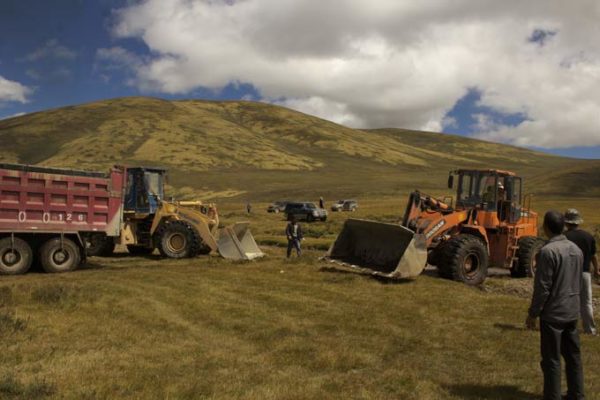
The new gold mining project on nomadic pastureland in Trindu, Yushu, Qinghai.
Correction:
Update and correction, May 10, 2016: ICT reported yesterday that Lhagang is in Minyak county, near Dartsedo (Kangding) City. To clarify, Lhagang is in Dartsedo (Kangding) county in Sichuan. The Tibetans who protested were from nomadic villages in Sichuan province, which a report by RFA made clear on May 9, naming Lhagang, Nangkor, Naglung, Kunmang and Nang nomadic villages in the Yulshok Gargye region. RFA reported that: “When the company prepared to resume operations, it released old, poisonous water from the mine, which drained into the Lung [Luchu] River and killed many fish.” This was also a deeply emotive issue for Tibetans in October, 2013, when Tibetans near a mining site in Lhagang brought large quantities of dead fish with them to present a petition to the township authorities calling for an end to the environmental destruction (documented by Tibet Watch in their thematic report, Environmental Protests on the Tibetan Plateau, January, 2015).
Footnotes:
[1] Lhagang is in Dartsedo (Kangding) County.
[2] ICT report on the death of this respected and popular religious leader: https://www.https://savetibet.org/body-of-revered-tibetan-lama-tenzin-delek-rinpoche-cremated-in-remote-high-security-prison-facility/
[3] VOA report, May 6, 2015, http://www.voanews.com/content/chinese-police-clamp-down-tibetan-mining-protest/3319093.html
[4] The ore of rock lithium mined at Lhagang is called spodumene. Mining of this ore in Tibet has been on and off, largely because spodumene mining and processing is expensive compared to salt lake extraction, which is comparatively straightforward.
[5] http://www.thetibetpost.com/en/news/tibet/4998-tibetans-protest-against-chinese-mining-in-minyak-county-tibet
[6] Gabriel Lafitte, ‘Spoiling Tibet: China and Resource Nationalism on the Roof of the World’, Zed Books, 2013
[7] The Discovery History of Mineral Deposits of China – Tibet Autonomous Region (volume 25), Geology Publishing House, Beijing, 1996, 45-7
[8] See Gabriel Lafitte’s blog: http://rukor.org/tibetan-lithium-in-your-pocket/
[9] Gabriel Lafitte writes: “BYD started life as a battery maker that decided it would be more profitable to make cars, running on BYD lithium batteries. After much corporate hype, BYD consistently failed to deliver actual cars, and was also daunted by the short distances cars can travel without a recharge. So BYD shifted to buses, which have room underneath for massive lithium iron phosphate batteries, and has been demonstrating them to bus companies in the US and now London.” (http://rukor.org/tibetan-lithium-in-your-pocket/)

